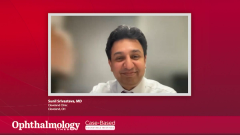
Managing Chronic Postoperative Uveitis: Patient Case 1
Sunil Srivastava, MD, presents a case of a 68-year-old female with eye pain and decreased vision following complicated cataract surgery.
This is a video synopsis of a discussion involving Dr. Sunil Srivastava who is a uveitis and retina specialist at Cleveland Clinic. Dr. Srivastava presented two cases during the Ophthalmology Times®roundtable at the Academy.
The first case involves a 68-year-old female who underwent a complicated cataract surgery in her left eye, resulting in a three-piece sulcus eye well placement. After experiencing complications, including trephination and lensectomy, the patient developed cystoid macular edema (CME) and inflammation postoperatively. The round table discussion focused on the initial approach to postoperative CME. The consensus leaned towards topical therapy, specifically difluprednate, with some considering periocular steroids during eye well placement.
Despite initial improvement, the patient required an intravitreal triamcinolone injection to control cystoid macular edema. The challenge in using a dexamethasone implant in a patient with a sutured eye well was emphasized, as it could lead to migration issues into the anterior chamber. Eventually, the patient received an intravitreal fluocinolone acetonide implant after recurring cystoid macular edema.
The discussion touched on defining chronic CME, with most agreeing on a timeframe between three and six months or based on the number of required treatments. Dr. Srivastava expressed a personal preference for considering chronicity around the six-month mark, especially for patients requiring multiple treatment regimens.
Following the fluocinolone implant, the patient showed improvement, but ongoing monitoring revealed a potential increase in intraocular pressure (IOP). Management included topical antihypertensive medication, ensuring careful observation for pressure-related complications. The patient demonstrated sustained improvement over a three-year follow-up, maintaining normal IOP and visual acuity at 20/32. This case illustrates the challenges in managing cystoid macular edema post-complicated cataract surgery and highlights the efficacy of long-term treatment with the fluocinolone implant.
Video synopsis is AI-generated and reviewed by Ophthalmology Times® editorial staff.
Newsletter
Don’t miss out—get Ophthalmology Times updates on the latest clinical advancements and expert interviews, straight to your inbox.






